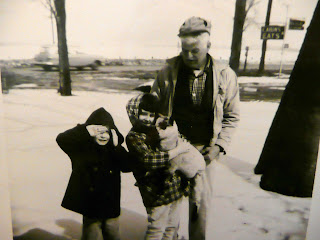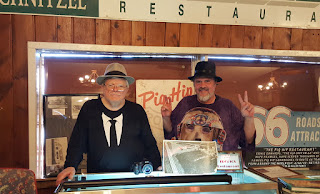Death on Route 66: The Murders of Gene Reed and Martin Drenovac - Part two
(First published in Show Me Route 66, Vol. 23 No 4, 2013
Second published in the Prairie Land Buzz, February 2014)
In 1961, two AWOL Texas GIs went on
a cross-country killing spree from Florida to Colorado, killing seven
people in a two-week orgy of robbery, violence, and murder. Their
travels brought James Douglas Latham, 19, and George Ronald York, 18,
to Illinois' Metro East, where they made several tragic stops. Their
senseless, brutal slayings of Albert Eugene “Gene” Reed and
Martin Drenovac along Route 66 sent the Illinois communities of
Litchfield, Edwardsville, and Mitchell/Granite City reeling. Reed and
Drenovac were victims #4 and #5 respectively of nine victims
assaulted (seven of which died) at the hands of Latham and York from
May 26 through June 10, 1961.
On the morning of
Thursday, June 8, 1961, Martin Drenovac was at work at his Twin Oaks
Gas for Less service station on U.S. Bypass 66 in Mitchell, Illinois.
The service station, along with a restaurant and motel, were all
owned by the Drenovac family and were located just before the
entrance to the Chain of Rocks Canal Bridge. The family – Martin,
wife Ethel, son Sam, daughter Anne, and two grandchildren – lived
in a large two-story house just west of the service station. Martin
was 69 years old but was still working; he had spent decades building
up businesses. Life was good.
 |
| Martin Drenovac with his grandson Richard and granddaughter Denise about 1959. Business signs can be seen to the right. Courtesy of Denise Madrid. |
A native of
Croatia, Martin Drenovac came to the U.S. in 1905. In nearby Hartford
and Wood River, he operated grocery stores for 27 years before moving
to Mitchell in 1947. He and his wife Ethel had two children, Anne and
Sam. Sam grew up working in the family businesses. Ann became a
school teacher; she married Alfred Madrid and they had two children,
Denise and Richard.
 |
| Interior of Drenovac's general store in Hartford in 1932. Pictured (left to right) are Ethel and Martin Drenovac, their daughter Ann, and store employees. Courtesy of Hartford Public Library. |
Granddaughter
Denise Madrid recalls the restaurant: It had been built from an old
barn and part of the front was remodeled with glass block; there was
a matching glass block bar inside. Just inside the front door was a
compass rose designed in the floor: as a child Denise liked to stand
in the middle of it and twirl. Her grandmother, Martin's wife Ethel,
grew up in Austria where she learned the fine art of baking. She was
famous locally for her pies. A half-moon window between the kitchen
and dining room was the spot where Ethel's fresh-baked pies would
appear. Martin and Ethel grew some of the produce used in the
restaurant, including about 200 tomato plants every year. Martin was
ahead of his time, employing the “farm to table” concept popular
now in many fine restaurants. The produce was grown organically. “We
don't spray, we don't spray,” Martin would tell customers.
Martin called his
businesses the Twin Oaks Restaurant and Rotel (“It's a hotel
on the road!”). The Rotel consisted of about 8-10 cabins,
one of which was an octagon. Although the whole business complex came
to be known as Twin Oaks, Denise says that the service station was
only named “Gas For Less” and was serviced by the Ashland Oil
Company. The restaurant and rotel were called “Twin Oaks.”
Denise remembers
her grandfather as a kind man with a big heart. The family was well
off due to their businesses. During the Great Depression, he provided
housing for a family who had nothing and nowhere to live. In the age
of segregation, he allowed blacks to eat in his restaurant and if
whites complained, he told them that they were welcome to take their
food outside.
But on June 8,
1961, the Drenovac family's peaceful existence was shattered. For
George Latham and Ronald York, their day had started with a brutal
murder – their fourth in a rampage of terror across the country.
That morning Albert Eugene “Gene” Reed from Litchfield had a
fateful rendezvous with Latham and York, attempting to give the two
“hitchhikers” a ride. But the killers had turned the tables. They
killed Reed, took over his late-model Dodge, and dumped his body
southwest of Edwardsville. From that spot it was only about seven
miles to Twin Oaks.
Martin was
watching over the service station that morning, while his wife Ethel
and son Sam were at work in the restaurant. Sam was wearing his
customary white shirt and white butcher's apron. Ethel was most
likely baking pies. York and Latham pulled into the service station
driving Reed's red Dodge. Meanwhile, Martin's grandchildren,
nine-year-old Denise and six-year-old Richard Madrid were playing a
game on the living room floor, their young world not yet shattered.
It was about 10:00 am.
A few minutes
later, Ethel looked out the restaurant window and saw a car at the
gas station waiting for service. She saw the customers sitting in
their car, but as she watched her husband Martin did not come out to
greet them. Son Sam went over to the service station. It was Sam that
found his father lying in a pool of blood in the service bay.
The parking lot
was soon jammed with police and sheriff vehicles. An ambulance waited
to load Martin's body as the investigation began. Sam walked over to
the Drenovac home where his niece and nephew were innocently playing.
Denise still remembers her Uncle Sam walking into the house with his
white shirt and apron “covered with blood.” He told them, “Your
grandfather's been killed. Call your mother and tell her to leave
school and come. Tell her your grandfather's really sick. But don't
tell her he's been killed.” Police investigations concluded that
Martin had been hit on the head at least seven times. The family
believes that the killers used the poker out of Martin's wood stove.
 |
| Emergency vehicles outside the service station and the ambulance waiting to load Martin Drenovac's body on June 8, 1961. Edwardsville Intelligencer. |
Although Gene Reed
already lay dead a few miles east, Drenovac's murder was reported
first, and it would still be several hours before Reed's body would
be found and reported. Initial investigations caused Madison County
Sheriff George Musso to state that there “was apparently no
connection between the Reed slaying and a fatal holdup and beating
near the Chain of Rocks Bridge.”
Martin's wallet,
believed to contain several hundred dollars in cash, was missing.
Weeks later, a man in Missouri found the wallet where Latham and York
had thrown it out. Knowing the story from the wide publicity after
the murders, the man wrote a letter to the Drenovac family at Twin
Oaks, alerting them that he had the wallet. Denise recalls the car
trip to Missouri to pick up her grandfather's wallet. Later on, in
their confessions Latham and York stated that they not only needed
gas in the Dodge, but cash for the Chain of Rocks Bridge toll.
After their escape
across the Mississippi River, the crime spree was not yet over. In
Kansas, they robbed and shot to death Otto Zeigler, a 63-year-old
railroad worker. In Colorado, they had sex with a teen-aged motel
maid named Rachel Moyer. That was before they killed her, too.
The pair was
finally apprehended in Salt Lake City, where they were still driving
Gene Reed's red Dodge. York and Latham confessed to seven murders,
two assaults, and six auto thefts. Madison County authorities went to
Salt Lake City in an attempt to bring the killers back to Illinois to
stand trial. “We feel that since the pair was arrested in the car
taken from one of the Madison county victims that we have the best
case against them,” State's Attorney Dick H. Mudge was quoted in
the Granite City Press-Record.
However, Kansas was given first chance to prosecute due to
“witnesses, physical evidence, and evidence independent of the
youths,” according to a later quote from Mudge in the Edwardsville
Intelligencer. York and Latham were convicted in Kansas of
shooting the Kansas man. They sat on death row with Perry Smith and
Dick Hickock, another pair of murderers who were the subject of
Truman Capote's book, “In Cold Blood.” After numerous appeals,
the pair was finally executed by hanging in 1965.
Martin Drenovac's
funeral was held on the Monday after his death. He left behind his
wife Ethel, son Sam, daughter Anne, and the two grandchildren. Sam
continued to run the family businesses for awhile and entered
politics in later years. The family continued to live next door to
the service station in the big house. Ethel passed away in 1984 and
Anne in 1985. The grandchildren eventually moved away from the area.
In recent years Sam stayed in the house as it deteriorated and the
vegetation grew up around it. The crumbling gas station with the tall
“Twin Oaks Gas for Less” sign in front has become an iconic
image. The sign was damaged by a storm a few years ago and eventually
disappeared. Perhaps it's safe in someone's memorabilia collection.
Sam now lives in a nursing home as he approaches his 90th
birthday. He hangs on to his dream of returning to the family home
next to the station.
 |
| The Twin Oaks sign in the early 2000s--long after Martin Drenovac's murder but before a storm damaged the sign. Photo by Joe Sonderman. |



I have always liked exploring old properties. Last week, completely unaware of any of the history and murder that took place there, I walked around what remains of the service station and house. It wasn't until I posted pictures in a Facebook group about abandoned Illinois properties that I learned what had happened there, and until reading this that I learned they lived in the house next door. It is so sad to imagine how well off and happy this family was, and how such a terrible act of evil on that day took this man away from his family, and their joy with it. The remains of a concrete goldfish pond are in the backyard. I imagine what it must have looked like back then, before it all became overgrown with trees and strewn with debris and items that belonged to this family. I feel bad that these places, the house and service station meant so much to these people, and that such a tragedy happened there. And now all that remains are crumbling structures, and the world has forgotten. There should be some sort of roadside memorial detailing this.
ReplyDeleteGreat story my parents knew Mr. Drenovac. Sadly the Gas Station is barely anything left.
ReplyDeleteThis comment has been removed by the author.
ReplyDelete